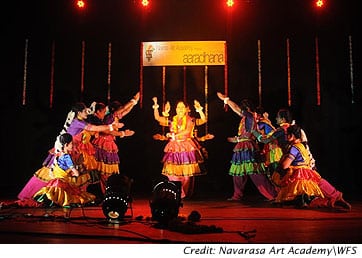
 MUMBAI, India (WOMENSENEWS)–A few years ago it seemed as though every street corner in this city was offering a dance class to match steps with the latest hit Hindi film song. Women throughout the city spent hours perfecting their moves for performances during religious festivities and family functions.
MUMBAI, India (WOMENSENEWS)–A few years ago it seemed as though every street corner in this city was offering a dance class to match steps with the latest hit Hindi film song. Women throughout the city spent hours perfecting their moves for performances during religious festivities and family functions.
But these days dancing is no longer just about Bollywood. Mumbai girls and women are now also paying serious attention to folk and traditional dance styles.
Whether they engage in an impromptu group dance on festive occasions or more formalized wedding ceremonies, women are taking these old steps seriously, says Radhika Phanse, a classical dance teacher who specializes in Kathak, one of the eight forms of Indian classical dance. "They want to look professional and not ham around with some amateurish steps."
Phanse has been running Navarasa Art Academy in Dadar, Mumbai, for the last 15 years.
Five years ago, she began teaching folk dances and started attracting a wider age group.
"In our classical dance classes we have students from the age group of 6 to 25 years," says Phanse. "But for folk-dance forms we get people from 20 to 60 years." Students, she says, include homemakers, doctors, lecturers, CEOs and call-center workers.
The simple, repetitive steps are popular in part because a whole group of people can join in and share a sense of celebration.
Heart-Rending Lyrics
Vinod Kumari gives folk and classical lessons in the suburb of Andheri.
"I believe that folk songs have some real heart-rending lyrics and simple words always manage to express every kind of emotion to suit a given situation," she says. "Even feelings of love and longing can be expressed in a beautiful way without sounding vulgar or obnoxious. And dances set to these songs always exude grace, whether they are being performed by young girls or elderly women. It’s really sad to see small children gyrating to Bollywood numbers on reality shows on television these days."
India offers an array of folk dances. Every state and region has its own form. Nagaland in the Northeast, for instance, has war dances and harvest dances, with dancers wearing traditional head gear, arm bands and an above-the-knee skirt. One southern state has a snake dance.
This year, Rashmi Chedda, an engineering student in Mumbai, learned a dance called the Dandiya, which comes from Gujarat State.
"Every year when my college held a Dandiya night during the Navaratri festival, my friends and I always remained on the sidelines as we didn’t know the actual dance and didn’t want to make a fool of ourselves," says Chedda. "This year, we decided to train properly and so we went in for proper dance classes and thoroughly enjoyed them."
‘Fluid and Graceful Movements’
Kirti Gupta, a student of a South Mumbai college, says folk-dance classes suit her busy schedule.
"I love dancing but at present I don’t have the time to learn a classical form. And my parents definitely won’t let me dance to Hindi film music. So I started learning folk and now I don’t want to leave it. All Indian folk dances have such fluid and graceful movements and I want to learn as many as I can," she says.
Dance instructor Kumari says some of her folk-dance students are TV actors who show up to class after they finish shooting their scenes.
"I teach them simple folk dances, particularly the Rajsthani Radha Krishna dance form from which they learn to show ‘shringar ras’ (love), ‘hasya ras’ (laughter) and even ‘roudra ras’ (anger) with ease," she explains.
Dr. Sulochana Parekh, a gynecologist, is also taking a folk-dance class. "After spending grueling hours at the hospital, sometimes facing difficult deliveries, I love to unwind. I find that dancing to the soul-stirring verses from our folk songs is really pleasant and relaxing. The charming uncluttered easy movements of the dances make me–and some of my colleagues who join in–really happy!"
Would you like to Comment but not sure how? Visit our help page at https://womensenews.org/help-making-comments-womens-enews-stories.
Would you like to Send Along a Link of This Story?
https://womensenews.org/story/arts/111016/traditional-folk-dance-picks-pace-in-mumbai
This article is adapted from one that was released by the Women’s Feature Service. For more articles on women’s issues log on to: http://www.wfsnews.org.
Surekha Kadapa-Bose is a Mumbai-based freelance journalist. She writes extensively on women’s rights, the environment and films.


